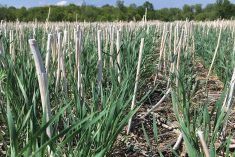Two permanent outlet channels will be built at a cost of $250 million to lower water levels on Lake Manitoba and prevent a repeat of the severe flooding seen in 2011.
“We’re going to do all the studies, get the ball rolling on this in a way that we can bring this into play so we can have a long-term solution for the people who were impacted by the 2011 flood,” said Premier Greg Selinger. “It’s going to make these people’s lives more stable for the future.”
Read Also

CUSMA access key among other trade noise: Seeds Canada panel
Seeds Canada conference panelists say Canada needs to stay focused and wait as U.S. trade and tariff chaos develops, and a Canada-U.S.-Mexico Agreement review looms
The plan is to make the temporary emergency channel from Lake St. Martin to Big Buffalo Lake built in the fall of 2011 permanent (and possibly larger) and add a new channel from Lake Manitoba to Lake St. Martin. Five possible routes have been identified for the latter, but engineers need to delve deeper into the amount of rock and clay that would have to be moved and determine the optimum outflow capacity. Engineering and design is expected to account for one-fifth of the $250-million price tag. Construction is forecast to begin in 2016, with completion within eight years.
The province expects Ottawa to pick up some of the cost and will use the one per cent hike in the PST to help fund its share, Selinger said.
The announcement was welcomed by Tom Teichroeb, head of the Lake Manitoba Flood Rehabilitation Committee.
“But I am concerned about the length of time they say it’s going to take, eight years is a long time, and if we can build an emergency channel in six months, surely we can do this faster than eight years,” said Teichroeb.
Two independent reports commissioned following the 2011 flood recommended the two-channel approach and Selinger said other flood mitigation recommendations are still under consideration.
Climate change is causing more extreme weather and that requires a “more aggressive mitigation style,” he said.
“We’ve seen three major flood risks in this province in the last five years, so that tells you that the gap between major events is shortening and the severity is increasing,” said Selinger.
It’s also hoped better mitigation will help lower the cost of compensation. To date, $850 million in compensation has been paid for the 2011 flood.
In the meantime, Teichroeb is hoping that amount will expand to cover damage from the 2011 flood that extended into 2012, something his organization has been fighting for.
“We’re still waiting,” he said.


















